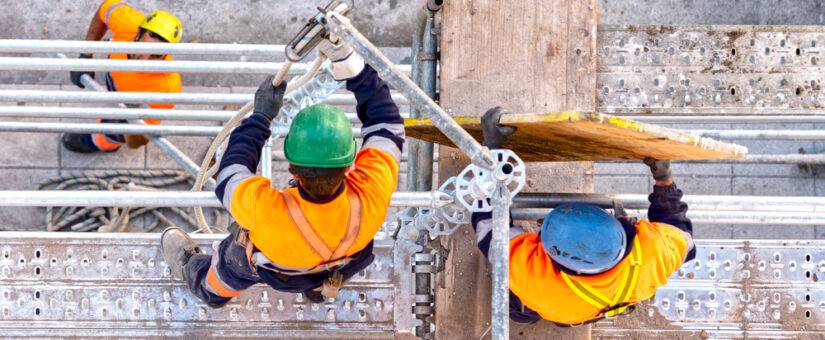
Scaffolding Safety in Construction
- Posted by admin
Working with heights is hazardous if proper precautions are not taken. Scaffolding-related accidents account for a substantial number of construction industry injuries each year.
According to the Occupational Safety and Health Administration (OSHA), approximately 4,500 scaffolding-related injuries occur annually, resulting in $90 million in lost workdays and other costs, such as increased insurance premiums and possible fines.
Fortunately, many of these mishaps are avoidable with proper planning. This article discusses safety tips that keep you safe while working on scaffolding.
Scaffolding Safety Tips and Hints
When proper safety protocols and procedures are followed, working on these structures can be as risk-free as any other elevated construction method. The following scaffolding safety tips keep you safe on the job:
Plank the Whole Bay
Cover the entire width of the scaffold with planks whenever possible. Proper covering increases the work area and decreases the risk of falling. Install another plank a little higher up to create a guardrail, especially when working midway up ladder frames. A diagonal “gooser” brace should be installed when working on casters. It maintains the scaffold’s squareness and stability.
How to Set Up Scaffolding Safely
Install the wheels or base jacks first so you do not have to lift the entire scaffold to insert them. Next, install both diagonal supports on the same frame. It must remain upright with the aid of the cross braces. Next, install the second frame and attach its cross braces. Before putting the boards, slide the scaffold 14 inches away from the wall.
Install a GuardRail
Installing a guardrail is the most effective way to prevent accidental falls off the platform. If you are only wearing a safety belt and working on a scaffold without a guard rail, you may pull the entire set-up down, endangering everyone working in the area.
Maintain a Three-Point Grip
Maintain a three-point grasp at all times while ascending a scaffold. This rule implies you should always have one hand and two feet or have at least one foot and two hands in contact with the scaffold. Keep your body as close as possible to the frame. In addition, never climb on the cross braces, as they were not built to support your weight.
Setting Up Scaffolding on an Uneven Ground
Wheels or base plates are designed for use with scaffolding frames. If left out, the frame tubes may be damaged and weakened structurally. Even if you are utilizing a base plate, place a 2×10 wooden block beneath each leg. This placement prevents the vehicle from sinking into soft dirt or hot asphalt.
When working with concrete, placing scaffolding on the blocks is unnecessary. An uneven floor or a subbase with modest bulging can create a small mating surface. The wood’s soft pliability ensures an excellently even weight distribution. Utilize an adjustable base jack to level and plumb the scaffolding when working on uneven areas. Never place scaffolding on piles of stone or wood.
Working on Scaffolding
Reduce the risk of tripping or kicking debris onto unsuspecting employees below by keeping the planks clear of impediments. Keep your tools and materials in buckets, caddies, and toolboxes wherever practical. Install a 24-inch toe board to keep objects from falling.
Use wire to secure the corners. It is tempting to hang tools on the rails, but you should resist the urge. Increasing the weight of the railings raises the likelihood that they will collapse if someone leans on them. Always urge workers on the ground to wear hard helmets.
Don’t Mix and Match
Combining different types of scaffolding can result in an unstable and hazardous platform. In addition, the fact that most scaffold frames are yellow does not imply that they are identical. There are at least five distinct scaffold designs, and most lack distinguishing markings. Frequently, the same manufacturer produces multiple different styles.
To add to the complexity, the variances between tube diameters and cross brace stud placements can be so minute that the pieces can “sort of” fit together. One can only be certain of the measurements by measuring the total frame dimensions, the interior and outside tube diameters, and the cross brace stud spacing.
Hire the Best Commercial Contractors in Dc, Maryland, and Virginia
A qualified individual should design every scaffold as they can undertake the necessary analysis to guarantee that it is appropriately designed. Wondering where you can get pros to complete the task? Look no further. Tech 24 Construction is your perfect fixer, as they help you achieve your project from the planning phases to the final nail. Contact us for inquiries or bid requests by filling out the contact form.
Image Credit / Shutterstock / ENRIQUE ALAEZ PEREZ


